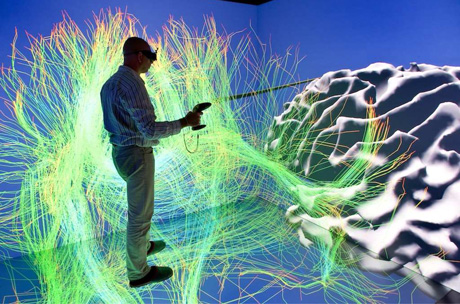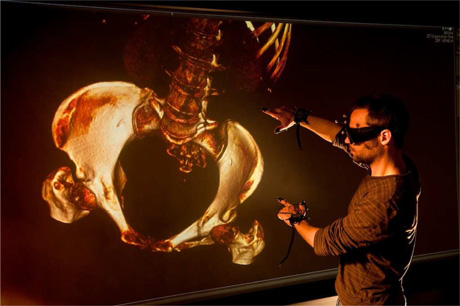by Jean-Christophe Lombardo and David Rey
Virtual Reality (VR) is a major area of research at INRIA’s research centre, Sophia Antipolis – Méditerranée (CRISAM). To complement this research activity and to stay at the forefront of VR research, CRISAM recently inaugurated its new VR facility: the “immersive space Gouraud-Phong”. The space is designed to prototype, test, and run VR applications in various fields including 3D interaction and immersion, scientific visualization, numerical simulation and medical imaging. This platform, located in Sophia Antipolis (France), is open to research collaborations, either with academic or industrial partners.

Figure 1: Immersive interaction with brain fibers and cortex reconstruted from MR Images.
The immersive space Gouraud-Phong comprises two distinct workspaces: CadWall, an image wall (powerwall) and iSpace, a CAVE-like environment (an immersive cube) offering both high resolution stereo rendering and spatial audio rendering on loudspeakers or with headphones, as well as optical tracking. Furthermore, a dedicated engineering support team is available to help users migrate software applications to the platform, transforming the application from a simple visualization program to a highly immersive one.
The platform has been designed to cover three main aspects:
- Visualization: for 2D, 3D, and multi-D data and results
- Immersion: users have to feel immersed in the virtual environment
- Interaction: users interact with data, results, and even algorithms, as intuitively as possible.
The space has the following technical specifications:
- back projection on each screen
- optical tracking
- infitec stereo
- spatialized audio
- ]iSpace workspace: 4 screens (front, left, right, floor); 3,2m x 3,2m x 2,4m
- CadWall screen size: 4,1m x 1,4m
- high bandwidth, low latency Infiniband local network
- possible simultaneous use of both sets of equipment
- high bandwidth network connection to external PC clusters.
Who can use the platform?
Although this platform is intended for VR experts, it has been designed to be accessible by any researcher who manipulates data and to ease their progression from simple visualization toward fully immersive VR experiments.
The immersive space Gouraud-Phong based in Sophia Antipolis (France) is a shared research platform co-funded by the European Regional Development Fund (ERDF), the French Provence-Alpes-Côte d’Azur region and the French ministry of higher education and research via the agreement State-Region project Telius (CPER). Thus it is not only accessible to INRIA researchers, but to any research partnership, academic or industrial.
Furthermore, this platform has to ease cross-fertilization between scientific and technological results, knowledge and practices, in the field of virtual reality and its applications, by facilitating:
- The integration of users’ work/experiments over time within the platform to allow further developments;
- The networking of platforms in this domain to share experiences and practices across the board from the regional to the European scale.
Research application fields
The platform is firstly dedicated to the virtual reality and 3D interaction communities: it makes it possible to study and experiment with future improvements on this type of equipment (eg computer graphics algorithms, intuitive interaction modes, etc.).
Additionally, it is available for use as a research tool for scientists in other fields, for instance:
- scientific computation and visualization: numerical simulation (eg CFD, electromagnetism), computational geometry, etc.
- generation and use of 3D, multi-D, or large scale data: network and graph topologies, large databases, data from sensors, robotics environment, etc.
- immersive studies or tools used by designers, architects, doctors, psychologists, etc.
- collaborative applications.
Technical steps to utilize VR facilities
Starting by using the CadWall as a plug and play external screen to enjoy the display size, users can incrementally modify their software to enable it to handle stereoscopic rendering and head and gesture tracking. The user then implements multi-display capacity on a multi-GPU computer and switches to iSpace. The final step is to parallelize the software, running it on the graphical cluster to profit from the equipment’s maximal performance.
A step by step approach to VR:
- step 1: plug your computer into the CadWall to enjoy the large screen
- step 2: recompile your software on one of the facility’s computers (Linux or Windows) to benefit from stereoscopic rendering
- step 3: implement tracking:
- head tracking will provide the 1st immersion sensations, and allow to feel the presence of virtual objects
- gesture tracking allows natural interaction
- step 4: implement a multi-display version of your software on a multi-GPU computer, so you can use the iSpace and experience the large field of view immersion
- step 5: implement parallelism and switch to the graphical cluster to enhance performance.
Further steps might involve using the external PC cluster to compute interactive simulations or to use both pieces of equipment at once to setup collaborative VR experiments.

Figure 2: Bimanual interaction with realtime volume rendering.
A dedicated engineer helps researchers setup hardware and middleware and to develop software to get the most out of the platform. His role is also to ensure code re-usability so people can benefit from previous experiments.
Links:
http://www.inria.fr
http://www.inria.fr/sophia
http://www.inria.fr/sophia/dream
http://www.inria.fr/centres-de-recherche-inria/sophia-antipolis-mediterranee/innovation/plateformes-technologiques2
Please contact:
Jean-Christophe Lombardo
Technological head of the Gouraud-Phong platform
INRIA, France
Tel: +33 4 92 38 50 26
E-mail:
David Rey
Head of the development and experimentation department
INRIA, France
Tel: +33 4 92 38 77 21
E-mail:
George Drettakis
Scientific head of the Gouraud-Phong platform
INRIA, France
Tel: +33 4 92 38 50 32
E-mail:










